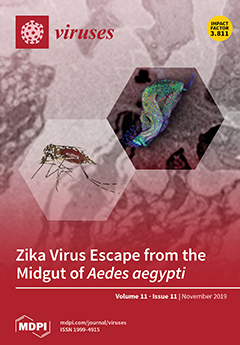Traditional pathogenesis studies of alphaviruses involves monitoring survival, viremia, and pathogen dissemination via serial necropsies; however, molecular imaging shifts this paradigm and provides a dynamic assessment of pathogen infection. Positron emission tomography (PET) with PET tracers targeted to study neuroinflammation (
N,
N-diethyl-2-[4-phenyl]-5,7-dimethylpyrazolo[1,5-a]pyrimidine-3-acetamide, [
18F]DPA-714), apoptosis (caspase-3 substrate, [
18F]CP-18), hypoxia (fluormisonidazole, [
18F]FMISO), blood–brain barrier (BBB) integrity ([
18F]albumin), and metabolism (fluorodeoxyglucose, [
18F]FDG) was performed on C3H/HeN mice infected intranasally with 7000 plaque-forming units (PFU) of Venezuelan equine encephalitis virus (VEEV) TC-83. The main findings are as follows: (1) whole-brain [
18F]DPA-714 and [
18F]CP-18 uptake increased three-fold demonstrating, neuroinflammation and apoptosis, respectively; (2) [
18F]albumin uptake increased by 25% across the brain demonstrating an altered BBB; (3) [
18F]FMISO uptake increased by 50% across the whole brain indicating hypoxic regions; (4) whole-brain [
18F]FDG uptake was unaffected; (5) [
18F]DPA-714 uptake in (a) cortex, thalamus, striatum, hypothalamus, and hippocampus increased through day seven and decreased by day 10 post exposure, (b) olfactory bulb increased at day three, peaked day seven, and decreased day 10, and (c) brain stem and cerebellum increased through day 10. In conclusion, intranasal exposure of C3H/HeN mice to VEEV TC-83 results in both time-dependent and regional increases in brain inflammation, apoptosis, and hypoxia, as well as modest decreases in BBB integrity; however, it has no effect on brain glucose metabolism.
Full article






